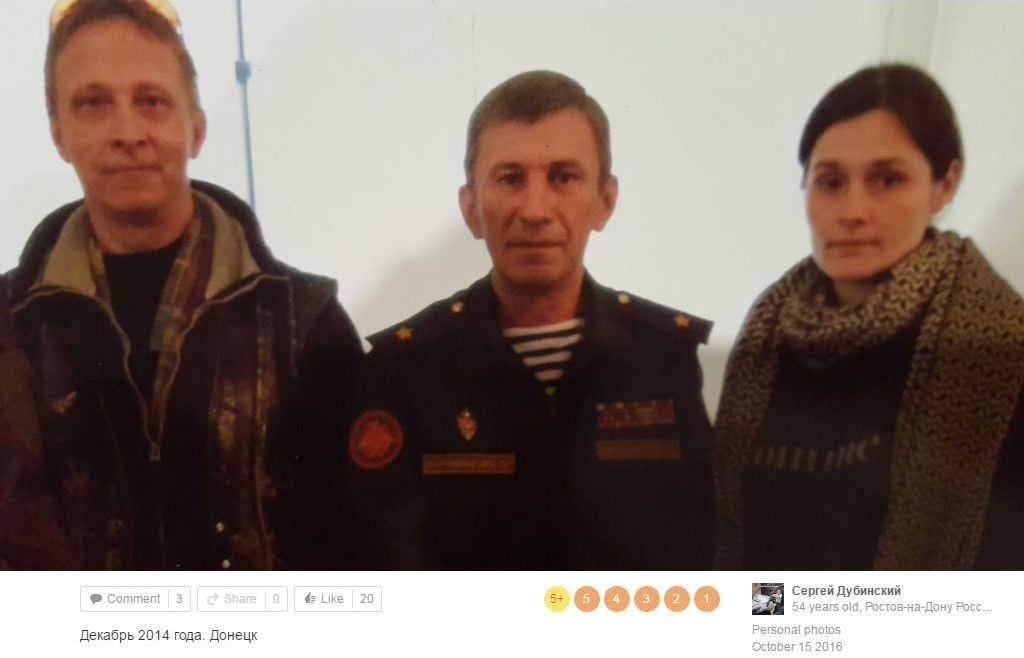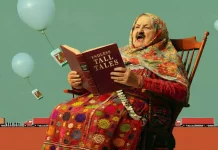By Bellingcat
“Sergey Dubinsky, with the call-sign Khmuryi — a respected Russian soldier, who honorably devoted his entire life to serve the Fatherland, even when his Fatherland entrusted him with senseless and harmful tasks in a period of social disorder in the mid-90s. He had already retired, but he was once again struck with bad luck: a coup took place in his native Ukraine, and as a soldier, he could do nothing except stand up in defense of the Constitution and joined up with the militia in Sloviansk under the flag of Strelkov.”

After the publication of our article, a number of readers commented on how Dubinsky had posted for some time on a message board at Glav.su, where he posted under the username “Нехороший” (Bad) in reference to the username “Bad Soldier” that he used in the Antikvariat forum. Numerous long-time users on the message board, including some separatists, confirmed the identity of Dubinsky/”Bad” in his time posting on the message board. He also made various posts that correspond with the biographical details of Dubinsky, such as an off-hand reference about his birthday that corresponds with Dubinsky’s birthday.
- On August 2, 2015, Dubinsky confirmed that the recordings with his voice released by the Security Services of Ukraine (SBU) on July 18, 2014 were authentic.
- In an attempt to confirm Dubinsky’s identity, a user asks him what car he often drove while he was in Sloviansk in June 2014. On July 12, 2015, Dubinsky replied that it was a black Peugeot 3008. The same type of car was filmed escorting Buk 332 through Makiivka on July 17, 2014, though this does not mean that Dubinsky was in the car at the time, but rather than it was used by men of the DNR intelligence services.
- On July 13, 2015, Dubinsky said that he had previously only been seen in a single video from May/June 2014, filmed in Kramatorsk.
Additional information regarding Sergey “Khmuryi” Dubinsky has also emerged since the publication of our article. On February 18, 2017, InformNapalm published an article showing that Dubinsky joined a congress of the “Union of Donbas Volunteers,” which took place on November 4, 2016 in Moscow. Dubinsky himself gave comments to the BBC Russian Service in response to our article. Dubinsky did not refute his identity as Khmuryi, and instead claiming that a Ukrainian Buk was responsible for the downing of MH17, though the location provided by the Russian Ministry of Defense for this supposed Ukrainian Buk shootdown has been thoroughly debunked.
 With Sergey Dubinsky’s identity as “Khmuryi” confirmed beyond all reasonable doubt, both in his additional discovered posts and confirmation from his friend Ivan Okhlobystin, we can now provide additional analysis regarding Dubinsky’s role in the transport of Buk 332 on July 17, 2014 through eastern Ukraine. As this analysis will show, Dubinsky was a key–or perhaps even the key–figure in organizing the transport of Buk 332 from Donetsk to a field south of Snizhne on the day of the tragedy. Furthermore, this additional analysis confirms the authenticity of the intercepted telephone conversations involving Dubinsky published by the SBU on July 18, 2014. Some details of these calls were previously under dispute or unclear, such as references to downed jets and Gvozdikas in a call between Dubinsky and “Botsman,” but a closer look reveals that even minor details in the calls can be verified through open source materials.
With Sergey Dubinsky’s identity as “Khmuryi” confirmed beyond all reasonable doubt, both in his additional discovered posts and confirmation from his friend Ivan Okhlobystin, we can now provide additional analysis regarding Dubinsky’s role in the transport of Buk 332 on July 17, 2014 through eastern Ukraine. As this analysis will show, Dubinsky was a key–or perhaps even the key–figure in organizing the transport of Buk 332 from Donetsk to a field south of Snizhne on the day of the tragedy. Furthermore, this additional analysis confirms the authenticity of the intercepted telephone conversations involving Dubinsky published by the SBU on July 18, 2014. Some details of these calls were previously under dispute or unclear, such as references to downed jets and Gvozdikas in a call between Dubinsky and “Botsman,” but a closer look reveals that even minor details in the calls can be verified through open source materials.
The following sections will provide both a summary and detailed analysis of the five calls involving Sergey “Khmuryi” Dubinsky published by both the SBU and JIT, along with additional commentary on some of the additional details provided in a slightly extended version of a call published by the JIT.
Dubinsky in Intercepted Calls Published by the SBU
Intercepted phone calls published by the Security Service of Ukraine (SBU) reveal numerous details about Dubinsky’s role around the transport of Russian Buk 332 on July 17, 2014. The day after the downing, the SBU identified Khmuryi (Dubinsky) as “Sergey Nikolayevich Petrovsky, born 1964, officer of the Russian GRU, Igor ‘Strelok’ Girkin’s deputy of intelligence, who was in Donetsk at the time of the intercept.” We now know that some of these details are true, and some are a bit off–namely, the year of birth (1962, not 1964) and his last name (Sergey Nikolayevich Dubinsky, not Petrovsky, which was his pseudonym in the DNR). Additionally, in one uploaded version of the conversations, the SBU duplicated information from a previous call (see summary of the fifth call). The SBU provides the number of the telephone that was intercepted: +38 063 121 3401. Two of the original videos published by the SBU can be accessed here (Ukrainian) and here (English). Dubinsky speaks at the following times in the video: 1:33 – 3:52, 4:15 – 5:22.
Summary of the first call (9:08am):
In the first conversation, Dubinsky speaks with “Buryatik,” a separatist soldier who has never been identified with certainty. Buryatik asks Dubinsky (Khmuryi) where to load a Buk-M1 (which is called a “beauty,” “Buk,” “B,” and “M” at different points), which was taken by Buryatik from an unidentified location to Donetsk. After asking where to unload and hide the Buk from the truck it was towed on, Buryatik confirms to Dubinsky that the Buk came with a crew. Dubinsky tells Buryatik that there is no need to unload and hide it, but instead said that it has to go “to there” now.
Analysis
- The time of this call (9:08am) is provided in the English version of the SBU video, along with the JIT’s video from March 30, 2015.
- It is unclear from the call if this “crew” (экипаж) came with the Buk from Russia, was a group of separatist soldiers, or was a mix of the two.
- The destination for the Buk mentioned by Dubinsky is presumably a field south of Snizhne, or another place meant to provide air defense cover to the area. This is quite logical for the time, as Ukrainian jets conducted airstrikes in the area around Snizhne at that time. The most well known example of this was an airstrike hitting an apartment building in Snizhne on July 15, killing 12 civilians. Satellite imagery further documents the presence of a Su-25 ground attack fighter in the area on July 16, 2014 (see coordinates 47.857925, 38.79837).
- A video published on March 30, 2015 by the Dutch-led Joint Investigation Team reveals a few extra seconds from this call, as detailed at the end of this article.
Summary of the second call (9:22am):
In the second phone conversation, which begins at 2:12 in the embedded video above, Dubinsky agains speaks with Buryatik. He asks if he brought one or two Buks. Buryatik explains that there was a mix-up with the transfer, as they did not have or were not willing to give/loan a second vehicle to transfer another Buk with. “They” unloaded the Buk from the truck they transported it on, and the Buk crossed the border on its own and was then transported with a truck. Dubinsky then tells Buryatik that the Buk will be going to its destination with tanks from the Vostok Battalion.
Analysis
- The time of the call (9:22am) is provided in the English version of the SBU video.
- Dubinsky expected a second vehicle with the delivery, though it is unclear what this would have been. It would be safe to assume that Dubinsky helped coordinate the transfer and use of the Buk, as he had some previous idea about what would be delivered, and Buryatik knew to call him for where the Buk would be moved or hidden.
- It’s not entirely clear what situation occurred when Buryatik described “the mix-up that they had” (у них там пошла непонятка). It is possible that he expected another transport vehicle to be used to take another Buk, or that “they” would conduct a portion of the transport themselves.
- The identity of “they” is unclear, referring to those in Russia who brought the Buk to the border. Buryatik never gives many identifying details, but we know that they had contact with the separatists, may have included crew members (see analysis of previous conversation), and they transported the Buk to the border.
- The exact crossing point for where the Buk crossed the border under its own power (“она своим ходом (…) перешла через полоску”), or where the transport vehicle was parked on the Ukrainian side of the border, is unclear. Of the possible candidates, an illegal border crossing point between Severnyi, Ukraine and Donetsk, Russia at 48.352967, 39.942758 seems most likely. For more information, see page 47 the Bellingcat report “Tracking the Trailers” and pages 11-13 of the Bellingcat report “Russia’s Path(s) to War“.
- In an interview with the now-defunct separatist news outlet icorpus (but saved on the blog El Murid), Dubinsky mentioned how he was allowed to take 3-4 tanks from the Vostok Battalion on the day of the downing of MH17: “…when I was going to Stepanivka, right before the Boeing crash, [Vostok Battalion commander] Khodakovsky called me for some reason instead of Igor Ivanovich [Girkin, “Strelkov”], and told me: “If you need to, you can take 3-4 of my tanks.” And I took them, because I did need to.“
- The transport of the Buk with the Vostok tanks did not take place exactly as explained. Arnold Greidanus and Ukraine@War (also see here) have done extensive analysis on the Vostok convoy that travelled along roughly the same route as the Buk, but at different times. Two videos of the Vostok convoy can be seen below:
Summary of the third call (9:23am):
Dubinsky speaks with a different person, “Sanych,” in the third call, starting at 2:43 in the previous embedded video. The SBU describes him as a fighter of the DNR and a deputy of Khmuryi (Dubinsky). In the call, Dubinsky tells Sanych that “my Buk-M” will go with “your guys,” and that the Buk is on a transport vehicle now. He asks Sanych about where to take it to place it in a military convoy. Sanych says to take it to the Motel roundabout.
Analysis
- The time of the call (9:23am) is provided in the English version of the SBU video.
- Buk 332 was parked at the Motel roundabout for some time (as filmed by a driver in this video), before it left eastward through Makiivka (filmed here), Zuhres (filmed here), Torez (photographed here), and finally Snizhne (filmed here).
- It is interesting that Dubinsky referred to the Buk as “my Buk,” again indicating that he was a key figure involved in acquiring and transporting the weapon from Russia.
- A key part of these intercepted calls is how we can see which separatists knew different instructions. Here, Dubinsky does not know where Buk 332 should be taken to send it off in a convoy, but he does know the ultimate destination and that it will be with or near Vostok tanks.
Summary of the fourth call (9:54am):
Dubinsky speaks with a new, unidentified person who is only described as a “DNR terrorist.” Dubinsky tells this person to call a man called “Bibliotekar” (The Librarian), and that he will find “you know what” at the Motel roundabout. The unidentified person affirms that he knows what “you know what” is. Dubinsky then instructs him to take “only those who came back, how ever many you need for the escort, and leave the rest behind here.” He then tells him to go to a spot near Pervomayskoe, and check a map for directions to the area. Once the unidentified soldier reaches the area near Pervomayskoe, Dubinsky tells him to set up and unload the remaining people he has with him. His tasks is to be in reserve and to guard the Buk-M that the person is transporting. He closes the call by saying that a man named Gyurza (The Viper) will also be at this location.
Analysis
- The time of the call (9:54am) is provided in the English version of the SBU video.
- The question of Bibliotekar’s identity has never been answered with any satisfaction. Many have investigated the question, but no one has answered who he is for certain. Some have guessed that he is a Russian soldier, perhaps from one of the intelligence services, though without any specific individual in mind. Others have pointed to Fyodor Berezin, who once served as a Soviet air defense officer, was called the “Russian Tom Clancy” by the New Yorker because of the science fiction and military books he authored, and served as the Deputy Defense Minister in the DNR in 2014. That said, it’s unclear if Berezin was in Donetsk at the time, and may have been in Luhansk, per his own LiveJournal posts. However, it would be a mistake to assume that “The Librarian” must be the call sign for a literary or bookish person–for example, “Bibliotekar” is a type of monster in the popular Ukrainian video game/Russian book series “Metro 2033,” which is where Arseny “Motorola” Pavlov’s “Sparta Battalion” took its symbol from. Resolving the issue of Bibliotekar’s identity would also settle some of the central questions surrounding the downing of MH17.
- It is unclear exactly what Dubinsky refers to when he says only “those who came back,” but it is possible that he is referring to the fighters in Girkin’s ranks who came back from Sloviansk about two weeks before the downing of MH17. These men would likely have more fighting experience than those who had only been in Donetsk and nearby cities.
- The people described by Dubinsky are likely those who followed Buk 332 in the escort from Donetsk to Snizhne, though not all of these vehicles were still in the convoy by the time it reached Snizhne. For example, in the Makiivka video from around 11:00am, the escort vehicles include a black Peugeot 3008, a UAZ-469 jeep, a grey 2010 Toyota RAV4 with a modified spoiler, and a dark blue Volkswagen minivan. In the Snizhne video, shot just a few hours before the downing, only one vehicle is still escorting the Buk.
- There are two “Pervomayskoe” villages located next to each other, and just down the road from the location where Buk 332 launched the missile that downed MH17. One village, closest to the launch site, is “Pervomaysky,” while another village just one field to the north is “Pervomayske.” It is unclear which one Dubinsky was talking about, but a separatist checkpoint was located in between Pervomaysky and the launch location, likely indicating that this was the village he had in mind.
- The identity of Gyurza is not entirely clear, as it is a common call sign for soldiers. He was likely Dubinsky’s deputy in the DNR’s intelligence service. Novaya Gazeta reported in 2015 that Gyurza was a former French foreign legionnaire, but this claim has not been independently confirmed.
Summary of the fifth call:
The fifth and final call, from the late afternoon or evening of July 17, 2014, is between Dubinsky and “Botsman,” identified by the SBU as an officer of the Russian GRU. Dubinsky tells Botsman that “we are near Marinovka” and things are not going too well. He says that things aren’t so great because they are under constant Grad fire, and that they had recently shot down a Ukrainian Su-25 jet. He mentions that his forces received a Buk-M that morning and that things will be easier now. Dubinsky goes on to say that Ukrainians are trying to escape from Zelenopolye, but to break through they have to go through Dubinsky and his forces. He also mentions that “yesterday” (July 16) they shot down two Su-25s, and another today. At the end of the call, Dubinsky says that “in a couple of hours” he’s headed to Donetsk, and that three Gvozdikas are waiting for him in Donetsk. He will then take the Gvozdikas back to “here” (Marinovka).
Analysis
- The time of the call is given as 9:08am and Dubinsky is described as in Donetsk–both of which are clearly false. The SBU almost certainly copied the top part of the first call for making the introduction frame for this call, only changing “Buryatik” for “Botsman”. Dubinsky describes his current location as Marinovka in this call, and the call was conducted after the morning and a shootdown with the Buk. The exact time of the call is unclear, but was likely in the late afternoon or very early evening soon after the downing of MH17, but before it became widely known that a passenger jet was actually downed.

- The identity of Botsman has never been determined, but Dubinsky describes a series of men who used the call sign in a September 13, 2015 post on Glav.su. He mentions a Botsman who was a deputy to Bezler, another who was the deputy commander of the 3rd Brigade from Horlivka, and a third in the “Viking” battalion of the DNR. Of these three, the first is the most likely candidate for the person on the call.
- There was indeed a large-scale battle near Marinovka shortly before the downing of MH17. On July 16, the day before the downing, a video appeared showing Igor “Strelkov” Girkin and Aleksandr Borodai in a field just northwest of Stepanivka, speaking about the fighting near Marinovka. A Strela-10 anti-aircraft missile system is visible in the video. Separatist forces moved into Marinovka during the day of July 17, and reportedly captured at least a portion of the village on the 16th.
- The shot down and damaged jets described to Dubinsky can be partially identified. He mentions downing two “Sushkas” (Su-25 jets) the day before the call. On July 16 at around 1pm, two Su-25s were hit, but only one was actually downed. Reports from separatist sources on that day indicate that the Su-25s were bombing near Savur-Mohyla– just a few kilometers from the eventual MH17 launch site, Marinovka, and the location where Strelkov conducted an interview with an anti-aircraft missile system in the background. Dubinsky was mistaken about the third “Sushka” that was shot down on the day of the call, as it was not a fighter jet he had first thought. The only plane that was shot at or downed that day was Malaysian Airlines Flight 17.
- We are able to identify the three Gvozdikas that Dubinsky mentions: three unnumbered and unmarked 2S1 Gvozdikas that travelled from Luhansk to Donetsk on July 15, 2014. A convoy accompanying these three Gvozdikas was filmed and photographed numerous times, as described in this Bellingcat investigation. These three Gvozdikas were seen on July 15 in central Donetsk around 7:00pm. Three of the same vehicles in this July 15 convoy–an UAZ-469, a 2010 Toyota RAV4, and a dark blue Volkswagen minivan–were in the convoy on July 17 that accompanied Buk 332 through eastern Ukraine. Dubinsky likely left Marinovka in the evening of July 17 — soon after the shootdown of MH17, judging from his comment on shooting down a new “Sushka” — and took his three Gvozdikas from Donetsk to Marinovka that night. Witness reports indicate that three Gvozdikas moved eastward from Donetsk in the late evening of July 17 and early morning of July 18:
@YevhenS , около15 минут назад по центру Макеевки в сторону Харцызска проехало 3 САУ “Гвоздика” #стоптеррор
— unhappy_teacher_ (@art_tr_) 17 июля 2014 г.
“About 15 minutes ago, three Gvozdikas passed through the center of Makiivka in the direction of Khartsyzka. #stopterror” (Archived)
About 45 minutes later, seemingly the same convoy moved through Zuhres, headed eastward along the same route that the MH17 convoy travelled.
@NikolasFather в Шахтерск движется колонна тяжелой техники, что в ней, в темноте не разглядеть
— MASH (@m_a_s_h_ua) 17 июля 2014 г.
“A convoy of heavy equipment is headed towards Shakhtarsk, but it’s hard to tell what’s all in it from the darkness.”
#Шахтерс в вашу сторону едет колонна тяжеллой техники, только что проехала Зугрес
— MASH (@m_a_s_h_ua) 17 июля 2014 г.
“#Shakhtersk a convoy of heavy equipment is headed your way, it just passed by Zuhres”
Dubinsky in Additional Calls Published by the JIT
The Dutch-led Joint Investigation Team also published intercepted telephone calls, but with some information censored (names) and other information added. In the first call described here from 9:08am–in which Dubinsky speaks to Buryatik about unloading the Buk–there is an extra segment at the end.
Buryatik tells Dubinsky that “they need some time to take a look at [the Buk].” After this, we can hear some conversation in the background. Dubinsky seems to be receiving information in the background here regarding the destination of the Buk, and says “wait a second, Bibliotekar.” It is not entirely clear, but it seems as if Bibliotekar may have been in the same room as Dubinsky during this call at 9:08am on the morning of July 17. Considering how Dubinsky mentioned Bibliotekar in a call to Sanych soon after this one, it is logical to conclude that he received information on where to haul the Buk from Bibliotekar.
The JIT published additional phone calls between separatists that took place the morning after the downing, but the identities of those in the call were not formally established.
Aftermath
Following the downing of MH17, Russian/separatist forces scrambled to retrieve the black boxes from MH17. They did eventually find them and on July 2;1, 2014 handed them over in a press conference to Malaysian officials.
In an intercepted call from July 18, 2014 and released by the SBU on July 21, the head of the Vostok Battalion, Aleksandr Khodakovsky, speaks with a separatist soldier about retrieving key items from the MH17 crash site.
While still searching for the black boxes (Khodakovsky later mentions not knowing what they look like), he mentions that Khmuryi (Dubinsky) has a “key item,” which could be a black box.
 It is unclear what this item was, but it is clear that Sergey Dubinsky was a key organizer in efforts to find materials related to MH17 at the crash site–with an emphasis that people from “Moscow” want them secured, and that these items “do not come into somebody else’s hands.”
It is unclear what this item was, but it is clear that Sergey Dubinsky was a key organizer in efforts to find materials related to MH17 at the crash site–with an emphasis that people from “Moscow” want them secured, and that these items “do not come into somebody else’s hands.”
By Bellingcat
This article was collaboratively researched and written by the Bellingcat MH17 Investigation Team, with contributions from the Conflict Intelligence Team.





